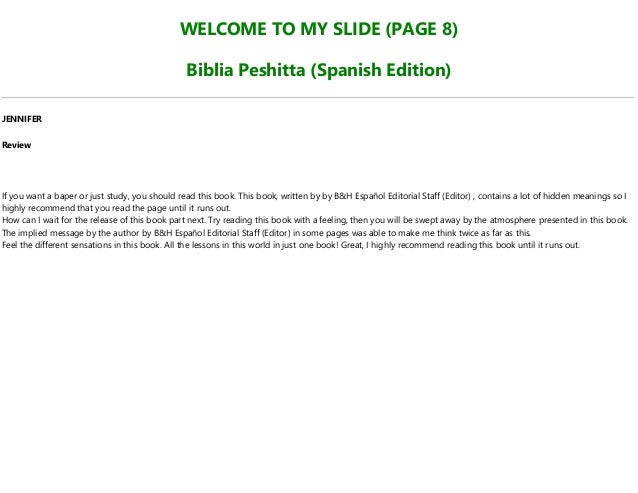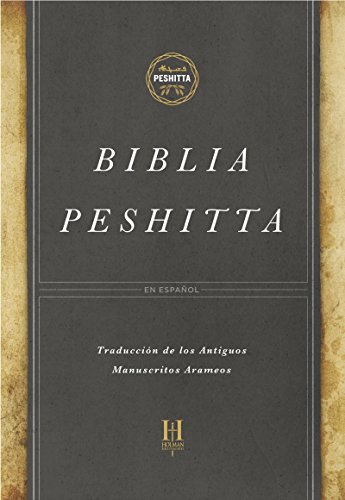This translation follows the Eastern Peshitta readings in almost every place where the Western Peshitto differs. It only goes with the Western reading three times. Until Andrew Gabriel Roth completed his Aramaic English New Testament, the Etheridge translation was the closest representative we had of the Eastern Peshitta text. I am trying to find a copy (pdf scan or facsimile) of several old Bibles and was wondering if anybody might either have some or know where I could find them. Tepl Bible – an old German Bible that was connected with the Waldensians and used by Martin Luther when he made his translation. It was named after the town of Tepl in Bohemia. Syriac Bibles on the Web. The most useful online tool for the study of the Syriac Peshitta New Testament is the Dukhrana Peshitta Tool, which gives full parsing information and multiple English translations through it's 'analyze' links. The English translations include Etheridge, Murdock, Lamsa, and the KJV.
The Peshitta is the official Bible of the Churchof the East. The name Peshitta in Aramaic means 'Straight',in other words, the original and pure New Testament. The Peshitta is theonly authentic and pure text which contains the books in the New Testament thatwere written in Aramaic, the Languageof Mshikha (the Messiah) and His Disciples.
In reference to the originality of the Peshitta, the words of His HolinessMar Eshai Shimun, Catholicos Patriarch of the Church of the East, are summarizedas follows:
'With reference to....the originality of the Peshitta text, as thePatriarch and Head of the Holy Apostolic and Catholic Church of the East, wewish to state, that the Church of the East received the scriptures from thehands of the blessed Apostles themselves in the Aramaic original, the languagespoken by our Lord Jesus Christ Himself, and that the Peshitta is the text ofthe Church of the East which has come down from the Biblical times withoutany change or revision.'
Mar Eshai Shimun
.jpg/1200px-Cod._Sangallensis_63_(277).jpg)
by Grace, Catholicos Patriarch of the East

April 5, 1957
Folio 154 verso of Sinai Syriac 2
(Peshitta, V century), John 17:7-17.
Thanks to Jean Valentin.
Peshitta NewTestament Ms.Variously identified as6th or 7th Century.
In reference to Aramaic, the Latin Patriarch Maximus atVatican II, stated:
'Christ, after all spoke in the language of Hiscontemporaries. He offered the first sacrifice of the Eucharist inAramaic, a language understood by all the people who heard Him. TheApostles and Disciples did the same and never in alanguage other than that of the gathered faithful.'
Codex Ambrosianus - 5th Century
Ambrosian Library, Milan, Italy.
Thanks to Alan Aldawood.
These are claims that are highly contested in WesternChristianity. The common misconception that the New Testament wasoriginally penned in Greek still persists today in a vast majority of Christiandenominations. Most scholars and theologians acknowledge that EshooMshikha, the Apostles, and the Jews in general spoke Aramaic indeed manyinstances of Aramaic survive in the Greek New testament manuscripts. However, they still maintain that the New Testament was penned in Greek by theApostles and disciples of Mshikha.
Aramaic Lectionary - about
A.D. 550.Pierpont Morgan Library
New York, N.Y.
The Church of the East has always rejected this claim. We believe that the Books of the New Testament were originally penned inAramaic, and later translated into Greek by first-century Gentile Christians inthe West, but never in the East, where the Aramaic was the Lingua Franca of thePersian Empire. We also hold and maintain that after the books weretranslated into Greek, the Aramaic originals were discarded, for by now theChurch in the West was almost completely Gentile and Greek-speaking. Thiswas not the case in the East, which had a Jewish majority (especially in Babylonand Adiabene) for a much longer period. Even when the Church of the Eastbecame mostly Gentile, the Aramaic was preserved and used rather than translatedinto the various vernacular languages of the regions to the East of theEuphrates river.
PeshittaOld Testament MS. - A.D. 464.Oldest datedBiblical Manuscript in existence. British Museum, Add. Ms. 14,425.Thanks to Alan Aldawood.

Peshitta MS.
(Exodus. xiii. 14-16)--A. D. 464.
(British Museum, Add. MS. 14; 425.)
Four books or the Pentateuch, viz:Genesis, Exodus, Numbers, and Deuteronomy according to the Peshitta version, inthe Estrangela characters. Written in the city of Amid, Assyria A. D. 464:the oldest dated Biblical manuscript in existence. From the monastery of St.Mary Deiyara in the Nitrian Desert of Egypt.
Even to the West of the Euphrates river, in the Holy Land,the main vernacular was Aramaic. The weekly synagogue lections, calledsidra or parashah, with the haphtarah, were accompanied by an oral Aramaictranslation, according to fixed traditions. A number of Targumim inAramaic were thus eventually committed to writing, some of which are ofunofficial character, and of considerable antiquity. The Gemara of theJerusalem Talmud was written in Aramaic, and received its definitive form inthe 5th century. The Babylonian Talmud with its commentaries on only 36of the Mishnah's 63 tractates, is four times as long as the JerusalemTalmud. These Gemaroth with much other material were gathered togethertoward the end of the 5th century, and are in Aramaic. Since 1947,approximately 500 documents were discovered in eleven caves of Wadi Qumran nearthe northwestern shore of the Dead Sea. In addition to the scrolls andfragments in Hebrew, there are portions and fragments of scrolls inAramaic. Hebrew and Aramaic, which are sister languages, have alwaysremained the most distinctive features marking Jewish and Eastern Christianreligious and cultural life, even to our present time.
Khaboris Manuscript. 4thCentury A.D.Hakkari mountains(Khda'Yab,'Adiabene'), Assyria.
Readings from the Book of Matti inthe Khaboris Manuscript.
The Aramaic inwhich the Bible called 'Assakhta Peshitta' is written, known as thePeshitta Text, is in the dialect of northwest Mesopotamia as it evolved and washighly perfected in Orhai, once a city-kingdom, later called Edessa by theGreeks, and now called Urfa in Turkey. Harran, the city of Abraham'sbrother Nahor, lies 38 kilometers southeast of Orhai. The large colony ofOrhai Jews, and the Jewish colonies in Assyria in the kingdom of Adiabene whoseroyal house had converted to Judaism, possessed most of the Bible in thisdialect, the Peshitta Tenakh. This version was taken over by all theChurches in the East, which used, and still use Aramaic, as far as India, andformerly in Turkestan and China. The Peshitta Tenakh was completed duringApostolic times with the writings of the New Testament.
Sample page from an Aramaicmanuscript in Estrangelo script (Beginning of 6th century AD)
For this diglot, I am using the Church of the East text ofthe Peshitta, in which I will be following the oriental sequence of the books,which places the General Epistles (Yaqub, Keepa and Yukhanan) immediately after theActs of the Apostles, and before the Epistles of Sha'ul (Paul). ThePeshitta does not contain four of the General Epistles (2 Keepa, 2 Yukhanan, 3Yukhanan and Yehuda), the book of Revelation, nor the story of the woman taken inadultery (Yukhanan 8.) These writings are not considered canonical by theChurch of the East, and have never been included in the the Canon of the Peshitta. The script used will be the original Estrangela, withoutvowel markings that were introduced during the 5th century.
Paul D. Younan
06/01/2000
Pdf Copy Of The Peshitta Book
Syriac Peshitta Resources
This is a mirror of http://aifoundations.org/peshitta/index.html which seems to be about to go down.
For PDF copies of these files click here.
A hard copy can be ordered from the American Bible Society.
Syriac New Testament with Psalms UBS, 1985. (Ancient Syriac) Jacobite script. (No longer available from ABS: try this link instead: Bible in my language).
The pointing of the text is based on use of the Syriac Electronic Data Retrieval Archive (SEDRA), developed by George A. Kiraz, and distributed by the Syriac Computing Center.
For additional information on the structure of the Database, see G. Kiraz, `Automatic Concordance Generation of Syriac Texts', in VI Symposium Syriacum 1992, ed. R. Lavenant, Orientalia Christiana Analecta 247, Rome, 1994.
The Syriac Computing Center / Beth Mardutho: The Syriac Institute
In order to properly view the text in Syriac, one should make use of the Meltho fonts distributed by Beth Mardutho. Currently there exists support for the following operating systems: Microsoft Windows XP/2000, Linux/BSD, Unix, and Mac OS X. For further information see the Meltho font page.
Some English translations:
'Murdock, James P.', The New Testament: Translated from the Syriac Peshito Version (1852) NOW OFFLINE: still available at Archive.org here.

Other links:
The text of the Peshitta Old Testament (Peshitta Institute, Leiden) can be downloaded at the Comprehensive Aramaic Lexicon web site.
A number of online Syriac texts and grammars can be downloaded here.
Some Aramaic links:
Dictionary of the Targumim, the Talmud Babli and Yerushalmi, and the Midrashic Literature, by Marcus Jastrow
Constructive feedback is welcomed to Roger Pearse.
Pdf Copy Of The Peshitta Law

Mirrored 3rd April 2007.
This page has been online since 3rd April 2007.
Return to Roger Pearse's Pages